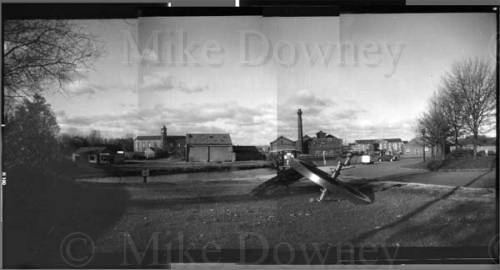Box Brownie Photography |
Story location: Home / photography / |
| 29/Nov/2002 |
I recently inherited an old Kodak Box Brownie - a Portrait Hawkeye. Despite the camera being around 70 years old, the film for it is still available.
I popped down to my local camera shop, bought a couple of rolls of ISO 100 film in 120 format, and tried to thread in onto the take-up spool in the camera. Loading the camera is pretty much the same as any old style medium format camera - much more difficult than todays modern machines. When you consider that this camera was supposed to be a simple to operate 'camera for the masses', you realise that back then, manufacturers expected users to put a bit more effort into their photography. Modern photographers who have been brought up on autofocus 35mm or APS would be horrified to see how complicated the film loading procedure was.
I realised than the lens wouldn't be very good by modern standards, so I decided to contact print the negatives (another reason for contact printing is that my enlarger doesn't go up to 6x9cm negatives). I also thought it would be a good idea to take a 'panoramic' shot, by holding the camera vertically and taking several exposures side by side. This wasn't as easy as I expected, because the Brownie viewfinder wasn't very clear, but I managed to take 4 overlapping shots, which fitted together fairly well.

One of the Brownie Panoramas as described above. This one was taken near the Boat Museum, in Ellesmere Port. One disadvantage of taking this kind of photo is thay you only get 2 actual shots on a roll of film (the 6x9cm format used by the Brownie gives 8 frames per roll, and 4 frames are used per photograph).
ID-11/D-76 Film Developer |
Story location: Home / photography / |
| 20/Nov/2002 |
The standard published versions of ID-11 and D-76 are identical, and is reproduced below. The off the shelf versions are slightly different, but work in much the same way. Development times should be identical. It can be found in many books and internet sites. It is close enough to the off the shelf version for the same developing times to be used.
Water @ 40°C 500ml
Metol 2g
Sodium Sulphite 100g
Hydroquinone 5g
Borax 2g
Water to 1 litre
Dissolve the chemicals in the order listed. Ensure that each chemical is dissolved before adding the next.
ID-11 is designated as a general purpose fine grain developer, and is suitable for virtually every B&W film. Development times for it come with nearly all films. Although the developer may be used full strength (where it is poured back into the bottle and re-used, with an increase in development time for the next film) it is easier to use diluted, where it is treated as a one-shot developer. The most commonly used dilutions are 1+1 and 1+3. If times aren't given for diluted developer, then a good starting point is:
For 1+1, multiply the time in stock developer by 1.4
For 1+3, double the time in stock developer.
One problem with the formulation above is that it will slowly increase in activity over several months of storage (apparently because of oxidation of the hydroquinone. This increases the alkalinity of the developer). One possibility (which I haven't tried) is to use 8g of Borax and 8g of Boric acid. This should give sufficient buffering to keep the developer activity constant. Another solution would be to keep the developer and borax separate. This lowers the alkalinity of the stored solution, which should reduce the rate of oxidation of the hydroquione. If the developer is always used diluted 1+1, then two solutions may be prepared: one containing all the above ingredients except the borax, another containing 2g/litre of borax. Mixing equal volumes of these together will give the working strength solution equivalent to 1+1.
D-76H
This is another variation on the above formula, but without the hydroquinone. This removes the problem of increasing alkalinity.
Water @ 40°C 500ml
Metol 2.5g
Sodium Sulphite 100g
Borax 2g
Water to 1 litre
In use, the developer is identical to the standard ID-11/D-76
